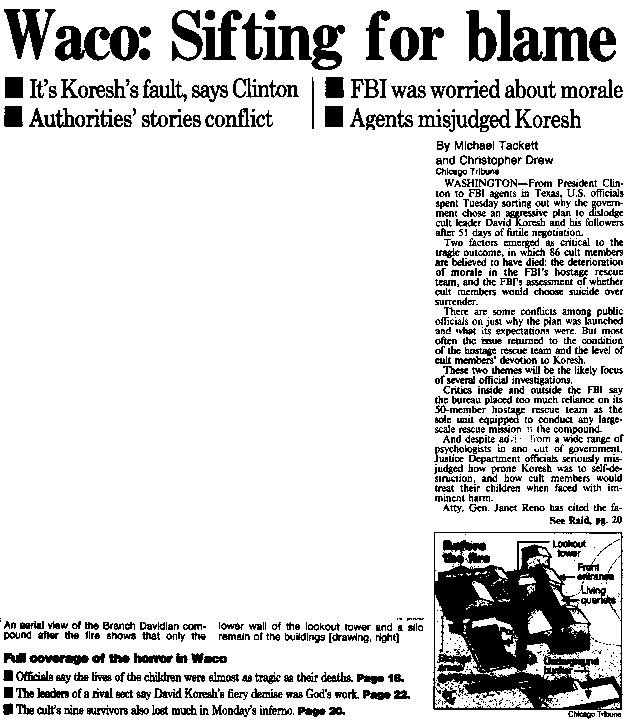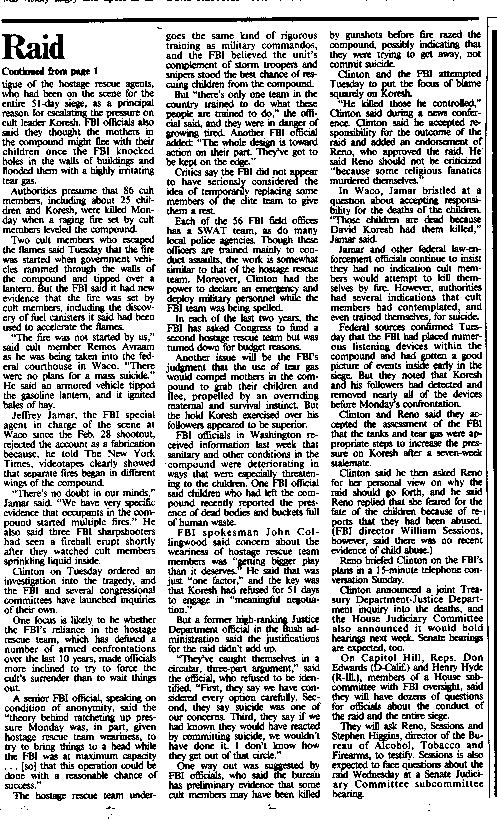Waco: Sifting for blame
By Michael Tackett and Christopher Drew
Chicago Tribune, April 21, 1993
Mechanically scanned for full legibility and cross reference
(emphasis added to aid viewer in locating cited material)


WASHINGTON -- From President Clinton to FBI agents in Texas, U.S. officials spent Tuesday sorting out why the government chose an aggressive plan to dislodge cult leader David Koresh and his followers after 51 days of futile negotiation.
Two factors emerged as critical to the tragic outcome, in which 86 cult members are believed to have died: the deterioration of morale in the FBI's hostage rescue team, and the FBI's assessment of whether cult members would choose suicide over surrender.
There are some conflicts among public officials on just why the plan was launched and what its expectations were. But most often the issue returned to the condition of the hostage rescue team and the level of cult members' devotion to Koresh.
These two themes will be the likely focus of several official investigations.
Critics inside and outside the FBI say the bureau placed too much reliance on its 50-member hostage rescue team as the sole unit equipped to conduct any large-scale rescue mission at the compound.
And despite advice, from a wide range of psychologists in and out of government, Justice Department officials seriously misjudged how prone Koresh was to self-destruction, and how cult members would treat their children when faced with imminent harm.
Atty. Gen. Janet Reno has cited the fatigue of the hostage rescue agents, who had been on the scene for the entire 51-day siege, as a principal reason for escalating the pressure on cult leader Koresh. FBI officials also said they thought the mothers in the compound might flee with their children once the FBI knocked holes in the walls of buildings and flooded them with a highly irritating tear gas.
Authorities presume that 86 cult members, including about 25 children and Koresh, were killed Monday when a raging fire set by cult members leveled the compound.
Two cult members who escaped the flames said Tuesday that the fire was started when government vehicles rammed through the walls of the compound and tipped over a lantern. But the FBI said it had new evidence that the fire was set by cult members, including the discovery of fuel canisters it said had been used to accelerate the flames.
"The fire was not started by us," said cult member Renos Avraam as he was being taken into the federal courthouse in Waco. "There were no plans for a mass suicide."
He said an armored vehicle tipped the gasoline lantern, and it ignited bales of hay.
Jeffrey Jamar, the FBI special agent in charge of the scene at Waco since the Feb. 28 shootout, rejected the account as a fabrication because, he told The New York Times, videotapes clearly showed that separate fires began in different wings of the compound.
"There's no doubt in our minds," Jamar said. "We have very specific evidence that occupants in the compound started multiple fires." He also, said three FBI sharpshooters had seen a fireball erupt shortly after they watched cult members sprinkling liquid inside.
Clinton on Tuesday ordered an investigation into the tragedy, and the FBI and several congressional committees have launched inquiries of their own.
One focus is likely to be whether the FBl's reliance in the hostage rescue team, which has defused a number of armed confrontations over the last 10 years, made officials more inclined to try to force the cult's surrender than to wait things out.
A senior FBI official, speaking on condition of anonymity, said the "theory behind ratcheting up pressure Monday was, in part, given hostage rescue team weariness, to try to bring things to a head while the FBI was at maximum capacity ..."so" that this operation could be done with a reasonable chance of FBI of success."
The hostage rescue team undergoes the same kind of rigorous training as military commandos, and the FBI believed the unit's complement of storm troopers and snipers stood the best chance of rescuing children from the compound.
But "there's only one team in the country trained to do what these people are trained to do," the official said, and they were in danger of growing tired. Another FBI official added: "The whole design is toward action on their part. They've got to be kept on the edge."
Critics say the FBI did not appear to have seriously considered the idea of temporarily replacing some members of the elite team to give them a rest.
Each of the 56 FBI field offices has a SWAT team, as do many local police agencies. Though these officers are trained mainly to conduct assaults, the work is somewhat similar to that of the hostage rescue team. Moreover, Clinton had the power to declare an emergency and deploy military personnel when the FBI team was being spelled.
In each of the last two years, the FBI has asked Congress to fund a second hostage rescue team but was turned down for budget reasons.
Another issue will be the FBI's judgment that the use of tear gas would compel mothers in the compound to grab their children and flee, propelled by an overriding maternal and survival instinct. But the hold Koresh exercised over his followers appeared to be superior.
FBI officials in Washington received information last week that sanitary and other conditions in the compound were deteriorating in ways that were especially threatening to the children. One FBI official said children who had left the compound recently reported the presence of dead bodies and buckets full of human waste.
FBI spokesman John Collingwood said concern about the weariness of hostage rescue team members was "getting bigger play than it deserves." He said that was just "one factor," and the key was that Koresh had refused for 51 days to engage in "meaningful negotiation."
But a former high-ranking Justice Department official in the Bush administration said the justifications for the raid didn't add up.
"They've caught themselves in a circular, three-part argument," said the official, who refused to be identified. "First, they say we have considered every option carefully. Second, they say suicide was one of our concerns. Third, they say if we had known they would have reacted by committing suicide, we wouldn't have done it. I don't know how they get out of that circle."
One way out was suggested by FBI officials, who said the bureau has preliminary evidence that some cult members may have been killed by gunshots before fire razed the compound, possibly indicating that they were trying to get away, not committed suicide.
Clinton and the FBI attempted Tuesday to put the focus of blame squarely on Koresh.
"He killed those he controlled," Clinton said during a news conference. Clinton said he accepted responsibility for the outcome of the raid and added an endorsement of Reno, who approved the raid. He said Reno should not be criticized "because some religious fanatics murdered themselves."
In Waco, Jamar bristled at a question about accepting responsibility for the deaths of the children. "Those children are dead because David Koresh had them killed," Jamar said.
Jamar and other federal law enforcement officials continue to insist they had no indication cult members would attempt to kill themselves by fire. However, authorities had several indications that cult members had contemplated, and even trained themselves, for suicide.
Federal sources confirmed Tuesday that the FBI had placed numerous listening devices within the compound and had gotten a good picture of events inside early in the siege. But they noted that Koresh and his followers had detected and removed nearly all of the devices before Monday's confrontation.
Clinton and Reno said they accepted the judgment of the FBI that the tanks and tear gas were appropriate steps to increase the pressure on Koresh after a seven-week stalemate.
Clinton said he then asked Reno for her personal view on why the raid should go forth, and he said Reno replied that she feared for the fate of the children because of reports that they had been abused. (FBI director William Sessions, however, said there was no recent evidence of child abuse.)
Reno briefed Clinton on the FBI's plans in a 15-minute telephone conversation Sunday.
Clinton announced a joint Treasury Department-Justice Department inquiry into the deaths, and the House Judiciary Committee also announced it would hold hearings next week. Senate hearings are expected, too.
On Capitol Hill, Reps. Don Edwards (D-Calif.) and Henry Hyde (R-M.), members of a House subcommittee with FBI oversight, said they will have dozens of questions for officials about the conduct of the raid and the entire siege.
They will ask Reno, Sessions and Stephen Higgins, director of the Bureau of Alcohol, Tobacco and Firearms, to testify. Sessions is also expected to face questions about the raid Wednesday at a Senate Judiciary Committee subcommittee hearing.
Home: Museum Entrance
Search: Museum Text